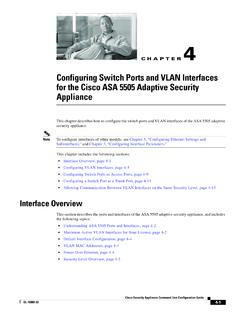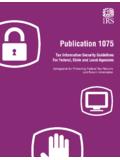Transcription of Configuring Port Security - Cisco
1 CHAPTER62-1 Cisco IOS Software configuration Guide, Release Port SecurityThis chapter describes how to configure the port Security feature. NoteFor complete syntax and usage information for the commands used in this chapter, see the Cisco IOS Master Command List, at this URL: TipFor additional information about Cisco Catalyst 6500 Series Switches (including configuration examples and troubleshooting information), see the documents listed on this page: Participate in the Technical Documentation Ideas forum This chapter consists of these sections.
2 Understanding Port Security , page 62-1 Default Port Security configuration , page 62-3 Port Security Guidelines and Restrictions, page 62-3 Configuring Port Security , page 62-5 Displaying Port Security Settings, page 62-12 Understanding Port SecurityThese sections describe port Security : Port Security with Dynamically Learned and Static MAC Addresses, page 62-2 Port Security with Sticky MAC Addresses, page 62-2 Port Security with IP Phones, page 62-362-2 Cisco IOS Software configuration Guide, Release 62 Configuring Port SecurityUnderstanding Port SecurityPort Security with Dynamically Learned and Static MAC AddressesYou can use port Security with dynamically learned and static MAC addresses to restrict a port s ingress traffic by limiting the MAC addresses that are allowed to send traffic into the port.
3 When you assign secure MAC addresses to a secure port, the port does not forward ingress traffic that has source addresses outside the group of defined addresses. If you limit the number of secure MAC addresses to one and assign a single secure MAC address, the device attached to that port has the full bandwidth of the Security violation occurs in either of these situations: When the maximum number of secure MAC addresses is reached on a secure port and the source MAC address of the ingress traffic is different from any of the identified secure MAC addresses, port Security applies the configured violation mode.
4 If traffic with a secure MAC address that is configured or learned on one secure port attempts to access another secure port in the same VLAN, applies the configured violation a secure MAC address is configured or learned on one secure port, the sequence of events that occurs when port Security detects that secure MAC address on a different port in the same VLAN is known as a MAC move the Configuring the Port Security Violation Mode on a Port section on page 62-6 for more information about the violation you have set the maximum number of secure MAC addresses on a port, port Security includes the secure addresses in the address table in one of these ways.
5 You can statically configure all secure MAC addresses by using the switchport port- Security mac-address mac_address interface configuration command. You can allow the port to dynamically configure secure MAC addresses with the MAC addresses of connected devices. You can statically configure a number of addresses and allow the rest to be dynamically configured. If the port has a link-down condition, all dynamically learned addresses are removed. Following bootup, a reload, or a link-down condition, port Security does not populate the address table with dynamically learned MAC addresses until the port receives ingress Security violation occurs if the maximum number of secure MAC addresses have been added to the address table and the port receives traffic from a MAC address that is not in the address table.
6 You can configure the port for one of three violation modes: protect, restrict, or shutdown. See the Configuring Port Security section on page ensure that an attached device has the full bandwidth of the port, set the maximum number of addresses to one and configure the MAC address of the attached Security with Sticky MAC AddressesPort Security with sticky MAC addresses provides many of the same benefits as port Security with static MAC addresses, but sticky MAC addresses can be learned dynamically. Port Security with sticky MAC addresses retains dynamically learned MAC addresses during a link-down you enter a write memory or copy running-config startup-config command, then port Security with sticky MAC addresses saves dynamically learned MAC addresses in the startup-config file and the port does not have to learn addresses from ingress traffic after bootup or a IOS Software configuration Guide.
7 Release 62 Configuring Port SecurityDefault Port Security ConfigurationPort Security with IP PhonesFigure 62-1 shows an application in which a device connects to the switch through the data port of an IP phone. Figure 62-1 Device Connected Through IP PhoneBecause the device is not directly connected to the switch, the switch cannot physically detect a loss of port link if the device is disconnected. Later Cisco IP phones send a Cisco Discovery Protocol (CDP) host presence type length value (TLV) to notify the switch of changes in the attached device s port link state.
8 With Cisco IOS Release (33)SXI and later releases, the switch recognizes the host presence TLV. Upon receiving a host presence TLV notification of a link down on the IP phone s data port, port Security removes from the address table all static, sticky, and dynamically learned MAC addresses. The removed addresses are added again only when the addresses are learned dynamically or Port Security ConfigurationTable 62-1 shows the default port Security configuration for an Security Guidelines and RestrictionsWhen Configuring port Security , follow these guidelines.
9 With the default port Security configuration , to bring all secure ports out of the error-disabled state, enter the errdisable recovery cause psecure-violation global configuration command, or manually reenable the port by entering the shutdown and no shut down interface configuration commands. Enter the clear port- Security dynamic global configuration command to clear all dynamically learned secure addresses. See the Cisco IOS Master Command List for complete syntax phoneSwitch188919 Table 62-1 Default Port Security ConfigurationFeatureDefault SettingPort number of secure MAC modeShutdown.
10 The port shuts down when the maximum number of secure MAC addresses is exceeded, and an SNMP trap notification is IOS Software configuration Guide, Release 62 Configuring Port SecurityPort Security Guidelines and Restrictions Port Security learns unauthorized MAC addresses with a bit set that causes traffic to them or from them to be dropped. The show mac-address-table command displays the unauthorized MAC addresses, but does not display the state of the bit. (CSCeb76844) To preserve dynamically learned sticky MAC addresses and configure them on a port following a bootup or a reload and after the dynamically learned sticky MAC addresses have been learned, you must enter a write memory or copy running-config startup-config command to save them in the startup-config file.















